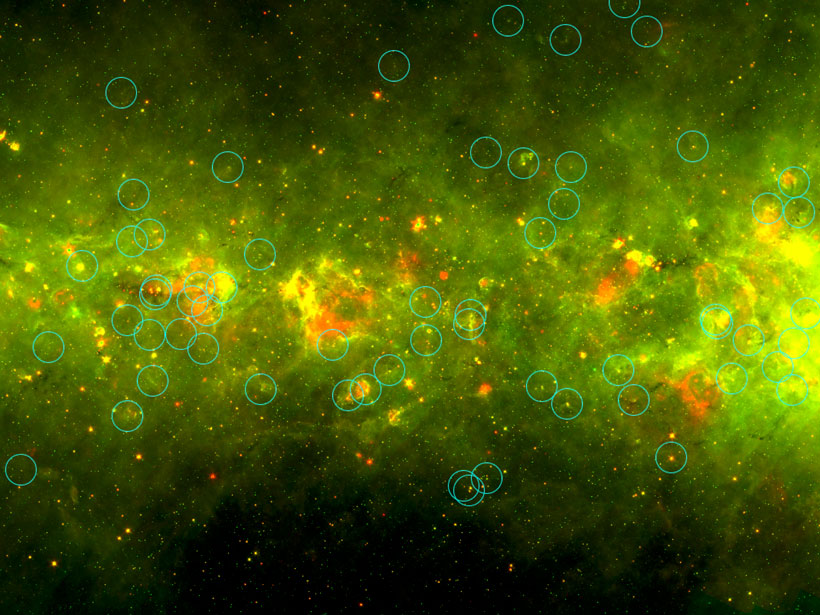When the Milky Way Project was added to the citizen science website Zooniverse, researchers asked volunteers to help them comb through thousands of online images obtained using NASA’s Spitzer Space Telescope and the Wide-field Infrared Survey Explorer.
Citizen scientists searched for infrared bubbles and bow shocks. In the process, they discovered “yellowballs.”
Researchers hadn’t even theorized about the existence of yellowballs prior to citizen scientists serendipitously tagging these mysterious objects in Spitzer Space Telescope images.
Researchers hadn’t even theorized about the existence of these compact infrared sources prior to citizen scientists serendipitously tagging the mysterious objects in the Spitzer Space Telescope images, said Grace Wolf-Chase, an astronomer at the Adler Planetarium in Chicago and one of the researchers on the study.
The potential for finding new or unusual objects, however, was baked into the Milky Way Project’s design. If volunteers found an object in the images that seemed usual, they were instructed to label it using their best guess about its identity or tag it using an “Other Object” tool. Not long after the first few yellowballs were tagged as other objects, “a lot of people started to notice them” and discuss them, said Matthew Povich, an associate professor of physics and astronomy at California State Polytechnic University, Pomona, and current principal investigator for the project. “People kept noticing that these things fit a pattern,” Povich said.
Robert Benjamin, who was a researcher on the Galactic Legacy Infrared Mid-Plane Survey Extraordinaire (GLIMPSE) survey in which many of the images were collected but wasn’t involved with the yellowball research, was “struck with…the simplicity of the explanation for the yellowballs,” he wrote in an email to Eos.
Each yellowball’s appearance in the images is a product of its compactness and the way different infrared wavelengths are represented in the images, according to a statement about the research. Small, warm dust particles show up as red, and polycyclic aromatic hydrocarbons (PAHs) appear green. The particles and the PAHs overlap in the yellowballs, giving rise to their round, yellow appearance in the images.
The team reported the initial yellowball discovery in a 2015 study published in the Astrophysical Journal in which researchers define these objects as “a mix of compact star-forming regions, including ultra-compact and compact H II regions, as well as analogous regions for less massive B-type stars.”
After the discovery was announced, the relaunched Milky Way Project included an intentional search for the yellowballs and an online tool specifically dedicated to tagging them, Povich said.
The Recent Catalog
Between 2016 and 2017, citizen scientists identified more than 6,000 yellowballs. However, the distance to each yellowball was known for only a small fraction of them, Wolf-Chase said, and “you really can’t say much about the physical nature” of yellowballs without knowing those distances.
Presently, the team has created a smaller catalog of 518 yellowballs whose distances have been determined. One of their recent results? Yellowballs “provide ‘snapshots’ in time of nascent star-forming regions spanning an enormous range of mass and luminosity,” according to the research statement.
Results of the Milky Way Project have shown the interrelatedness of yellowballs, bubbles, and bow shocks.
Results of the Milky Way Project have shown the interrelatedness of yellowballs, bubbles, and bow shocks, Povich said. In many cases, these objects may be connected to different stages in an evolutionary star sequence that can be represented by a bubble gum analogy, he said. The yellowball star-forming regions are each akin to a malleable lump of chewing gum in a person’s mouth. Space bubbles are, unsurprisingly, analogous to bubble gum bubbles. Finally, the bow shock is represented by the popping of the bubble. The results of recent research also suggest bow shocks may just be older versions of space bubbles, Povich said.
Going “Rogue”
“What was most novel about this project is the way these objects came to light. It’s another example of citizen scientists ‘going rogue’ and finding something that the [research] scientists didn’t really intend,” Benjamin noted.
The discovery is an example of “powerful things that people can do that machines can’t,” Wolf-Chase said. “The beauty of citizen science is that you can participate on all of these levels.”
Povich’s team’s “The Milky Way Project Second Data Release: Bubbles and Bow Shocks” was recently accepted for publication in the Monthly Notices of the Royal Astronomical Society. There are also multiple forthcoming papers on the yellowball research, Wolf-Chase said.
—Rachel Crowell (@writesRCrowell), Science Journalist
Citation:
Crowell, R. (2019), The “yellowball” catalog and the citizen science that helped define it, Eos, 100, https://doi.org/10.1029/2019EO129119. Published on 26 July 2019.
Text © 2019. The authors. CC BY-NC-ND 3.0
Except where otherwise noted, images are subject to copyright. Any reuse without express permission from the copyright owner is prohibited.

